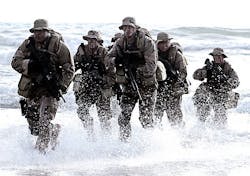Navy asks for new technologies in mine warfare, special operations, and expeditionary warfare
Researchers at Naval Sea Systems Command in Washington issued a solicitation Wednesday (N00024-17-R-6271) for the Confronting Irregular and Expeditionary Warfare Capability Challenges project to develop new technologies in mine warfare, naval special warfare, and naval expeditionary combat that apply to Navy programs of record or other acquisition programs.
Navy researchers are interested in new technologies that could be ready within one year, based on prototype demonstrations in realistic environments. Those interested have one year to submit ideas.
Mine warfare involves countering the enemy's use of different types of explosive devices like land mines and improvised explosive devices (IEDs), as well as ways to detect, locate, and neutralize floating and submerged sea mines.
Naval special warfare involves special operations forces like Navy SEALs and commando boat teams that operate independently, as part of U.S. Navy carrier battle groups and amphibious ready groups, or integrated with other U.S. special operations forces.
Naval expeditionary combat, meanwhile, involves rapid-deployment and self-sustaining forces like U.S. Marines that fight abroad and away from established bases using their own logistics and supporting arms.
story continues below
Navy researchers are asking industry for new technologies that can enable naval mine warfare, special warfare, and expeditionary combat forces to confront enemy irregular warfare, and to fill capability gaps in areas like explosive ordnance disposal (EOD).
Capabilities of interest involve reconnaissance, counter-terrorism, direct action, irregular warfare, foreign internal defense, and other urgent and emerging needs in mine warfare, special warfare, and expeditionary combat.
For mine warfare, Navy researchers want improved detection and classification sensors, buried mine detection, automated target recognition, computer-aided detection and classification, real-time data transfer of high-resolution sonar data, and two-way over-the-horizon (OTH) communications for large volumes of raw sonar and command-and-control data.
For naval special warfare, researchers are interested in multi-spectral sensors to improve situational awareness for manned and unmanned surface vessels and submarines operating in shallow coastal waters and harbors. Also of interest are power electronics technologies to connect manned and unmanned ships, boats, and submarines, as well as sensor technologies to improve vision during the day and at night.
For naval expeditionary combat, researchers are interested in technologies that help warfighters interact with target populations, identify threat activities, solve complex problems, and adapt to situations faster than an adversary. Also of interest are technologies that enable warfighters to analyze and handle foreign and domestic explosives, counter explosive hazards like IEDs, weapons of mass destruction (WMD), underwater mines, and other weaponry.
story continues below
In addition, the Navy wants new technologies that enable warfighters to operate in harbors, rivers, bays, and on beaches, as well as technologies that improve access to multi-intelligence, surveillance, and reconnaissance at the tactical edge.
Companies and organizations interested should send 8-page white papers no later than 1 Aug. 2018 by post or by courier to Commander, Naval Sea Systems Command, ATTN: Mr. Gregory Parkins, SEA 06-NSW (PMS340) 1244 Patterson Ave., SE, Bldg. 22, 4th Floor, Washington Navy Yard, Washington, D.C. 20376-7003. Those sending promising white papers may be invited to submit full technical and cost proposals.
Email technical questions or concerns to the Navy's Gregory Parkins at [email protected]. Email contractual questions or concerns to the Navy's Brad Watson at [email protected].
More information is online at https://www.fbo.gov/spg/DON/NAVSEA/NAVSEAHQ/N00024-17-R-6271/listing.html.
Learn more: search the Aerospace & Defense Buyer's Guide for companies, new products, press releases, and videos
